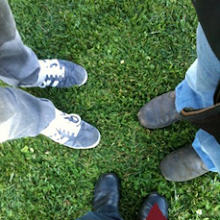Rare seahorses are born
at Hampshire Aquarium.

More than 120 endangered baby seahorses have been born at a Hampshire aquarium.
...........
...........
The arrival of the short-snouted seahorses at Portsmouth's Blue Reef Aquarium is part of a nationwide captive breeding programme.
...........
There are believed to be two separate species of seahorse found in British waters - the short-snouted and the long-snouted. The short-snouted seahorse is usually found in shallow muddy waters, estuaries or inshore among seaweed. Populations have been discovered along the south coast, in the River Thames, in the Channel Islands and Ireland.
............
Blue Reef Aquarium spokesman Robbie Robinson said: "This is the first time we have successfully bred short-snouted seahorses here and for so many to have been born is fantastic. "They are all being looked after in special nursery tanks and are being fed on a diet of microscopic live shrimp. "
.............
"It's obviously very early days but we're keeping our fingers crossed that many of the babies will survive into adulthood and help boost the captive bred populations of these endangered and beautiful fish."
.............
The seahorse is unique in the animal kingdom because it is the male rather than the female that carries the babies and gives birth to them via a special brood pouch on his stomach. The female seahorse lays her eggs in the male's pouch and he fertilises them and incubates them.
.............
There are about 34 species of seahorse in the world and virtually all of them are under threat from loss of habitat, pollution, the souvenir trade and traditional Far East medicine, which is thought to account for the deaths of more than 20 million seahorses every year.
...............
The short-snouted seahorse, or Hippocampus hippocampus, is protected under the Wildlife and Countryside Act 1981.
...............
My favorite part of the story:
...........
Seahorses have only one partner during their short lifetimes; 1 to 4 years. They perform greeting dances every morning to confirm their bond.
..............
Now if T and I could only dance each morning instead of yawning, groaning, and shuffling.
..........................................................

No comments:
Post a Comment